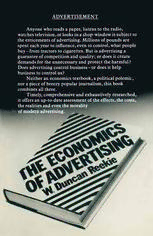
The Economics of Advertising PDF
Preview The Economics of Advertising
THE ECONOMICS OF ADVERTISING By the same author MANAGEMENT IN THE SOCIAL AND SAFETY SERVICES (with N. C. Hunt) ADVERTISING ECONOMICS OF THE PHARMACEUTICAL INDUSTRY PROFITS, POLITICS AND DRUGS (with M. H. Weber) THE CONSUMER SOCIETY (with I. R. C. Hirst) MANAGERIAL ECONOMICS INDUSTRY, PRICES AND MARKETS MACROECONOMICS FOR MANAGERS THE ECONOMICS OF ADVERTISING W. Duncan Reekie © W. Duncan Reekie 1981 Softcover reprint of the hardcover 1st edition 1981 978-0-333-27204-6 All rights reserved. No part of this publication may be reproduced or transmitted, in any form or by any means, without permission First published 1981 by THE MACMILLAN PRESS LT D London and Basingstoke Companies and representatives throughout the world Typeset by Santype International Ltd., Salisbury British Library Cataloguing in Publication Data Reekie, William Duncan The economics of advertising 1. Advertising I. Title 338.4'7'6591 HF5827 ISBN 978-1-349-04879-3 ISBN 978-1-349-04877-9 (eBook) DOI 10.1007/978-1-349-04877-9 For Natalie Contents List of Figures lX List of T abies X Preface xiii Acknowledgements XV 1 INTRODUCTION 1 Statistical Background 1 Plan and Purpose 13 2 FROM CONCEPTION TO MATURITY 15 The Development of the Mass Market 15 The Development of the Marketing Concept 16 The Increasing Depersonalisation of Selling 18 The Great Debate 20 3. SOCIAL AND ETHICAL PROBLEMS 24 Is Advertising in Bad Taste? 24 Is Advertising Excessive? 27 Is Advertising Untruthful? 28 Does Advertising Make People Buy what They do not Really Need? 32 Does Advertising Hamper Freedom of Speech? 36 4 HOW ADVERTISING DECISIONS ARE TAKEN 40 The Dorfman-Steiner Theorem 40 A Discontinuous Alternative 45 Vlll CONTENTS More Practical Approaches to Budget Determination 49 The Theory of the Optimum Promotional Mix 57 The Practice of Media Selection 70 5 ADVERTISING AND THE THEORY OF THE FIRM 80 Advertising as Information 80 Advertising as a Joint Product 89 Communication as a Transaction 91 The Market in Advertising Messages 92 6 97 ADVERTISING AND MONOPOLY Introduction 97 Seller Concentration Ratios 100 Barriers to Entry 102 Advertising is a Function of Competition 109 Competition is a Function of Advertising 110 Retailing Productivity 112 7 ADVERTISING AND PUBLIC POLICY 116 Scale Economies 116 Barriers to Entry 130 Retailing Productivity 153 8 CONCLUSIONS 167 Price 167 Profit 168 Protection of the Consumer by the 'Consumer Movement' 177 A Tax on Advertising 178 Legislation 184 Wanted: More Advertising and a New Theory of Competition? 186 Index 192 List of Figures 1·1 Total advertising expenditure, display expenditure and MCA expenditure at 1970 prices 1·2 Comparisons between total advertising expenditure, display expenditure and MCA expenditure with consumers' expen diture and GNP 1·3 Total advertising expenditure by media as percentage of total 2·1 The change from product orientation to market orientation 2·2 A model of the marketing channel 4·1 The Dorfman-Steiner model 4·2 Model for determining optimal input mix (after Verdoorn) 4·3 Recapitulation diagram (after Verdoorn) 4-4 Relationship of sales and profits to advertising expenditure 4·5 TV and press ad inputs: sales isoquants 4·6 Sales isoquants and ad design differences 4·7 Linear programming and advertising 4·8 The sales response function and LP analysis 5·1 Demand for advertising messages 5·2 A mutatis mutandis demand curve 6·1 (a) How the limit price may vary with advertising (b) Sales isoquants at different price-advertising combinations (c) Maintenance of output and raising of price through advertising 6·2 Advertising and the average cost curve 7·1 Frequency distribution of retail mark -ups m multiple retailers 8·1 Advertising, profit and net social benefits List of Tables 1.1 Total advertising expenditure and its relation to con sumers' expenditure and Gross National Product, 1960-77 1.2 Display advertising expenditure and its relation to con sumers' expenditure and Gross National Product 1.3 MCA expenditure and its relation to consumers' expendi- ture and Gross National Product 1.4 Total advertising expenditure by media 1.5 Total advertising expenditure by type 1.6 Sectoral breakdown of advertising by media 1.7 Estimated media expenditure by product group, 1969-77 3.1 Unilever's comparative marketing costs as a percentage of retail price 4.1 The firm's resultant profit (n, £'000) 4.2 The competitor's resultant profit (n, £'000) 4.3 Hypothetical readership distribution 4.4 Readership distribution patterns 4.5 Breakdown of reading frequency data 4.6 Reading frequency and sales effectiveness 5.1 Direction of demand variation 6.1 Advertising intensity and market shares 6.2 Margins, turnover per person and average wage/salary in certain trades, 1971 7.1 Unit production costs of domestic washing machines
